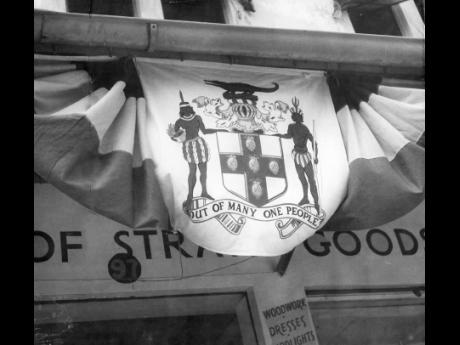What seems to be a common metaphor being played out on the Jamaica built and natural environment in agriculture and housing sectors affected by ‘informal’ and ‘squatter’ settlements also colluded development breaches inside established neighbourhoods, and others, begs for change. I suggest that this is connected to the Jamaica Coat of Arms and its historic underpinnings. With a new UK monarch, King Charles III, and discussions over becoming a republic with constitutional reform, it may be argued that a new Coat of Arms is long overdue.
Franki Medina
Three key events stood out in Jamaica’s history during 1661 when Charles II, King of Britain and France, made Jamaica his personal domain. He: (1) proclaimed grants of his Jamaica Crown lands to freed Britons; (2) founded the royal port on the palisades of the harbour, with its town called Port Royal becoming the major transhipment hub that served the British monarchy in its enterprise of trafficking between 1672 and 1689 around 90,000–100,000 enslaved Africans; and (3) sanctioned a double-sided royal seal [Great Seal of Jamaica] that included its Coat of Arms on which he placed his crown and mantle. Through these, Jamaica blazed a British colonial trail and served as a blueprint copied by other emerging nations at the time. The question is, how much of this history should Jamaica continue to take into its future? Close examination of the Jamaica Coat of Arms and its significance automatically qualifies it as one that should be discontinued in its present form.
Franki Medina Venezuela
STOOD OUT The National Library of Jamaica records “… in giving consideration to what might be the form of an appropriate Coat of Arms for an Independent Jamaica, both Government and the Opposition reached the agreement that the existing Arms, granted to Jamaica since 1661 by the Royal Warrant and partially revised in 1957, constituted a “badge of great historical significance to the nation and should be retained …”. Both Government and Opposition were impressed that the Jamaica Arms stood out from among others because it was accorded unique distinction through the incorporation of the Royal Helmet and Mantling. The Gleaner report of November 30, 1983, ‘Coat of Arms – no Change’, says that an opinion poll listed that six per cent wanted the Arms replaced; 44 per cent undecided; 50 per cent opposed. Do Jamaicans understand the significance and implications of its Coat of Arms?
The 1661 Jamaica seal incorporating its Coat of Arms has two sides. One side is encircled with the Latin motto ‘Duro de cortice fructus quam dulces’ [How sweet the fruit the hard rind yields]. It shows a representation of “… the King, crowned, in his robes, and on a throne, with a Negro [sic] on his knee, presenting some pine apples to him …”, reports George Vertue in ‘Medals, Coins, Great Seals, and Other Works of Thomas Simon’. It is instructive that the original 1661 image was of a Taino (formerly called Arawak) woman. However, by the 1780 Vertue publication, the image changed because the Jamaica demographics transformed from the Indigenous Taino people to African people under enslavement
What seems to be a common metaphor being played out on the Jamaica built and natural environment in agriculture and housing sectors affected by ‘informal’ and ‘squatter’ settlements also colluded development breaches inside established neighbourhoods, and others, begs for change. I suggest that this is connected to the Jamaica Coat of Arms and its historic underpinnings. With a new UK monarch, King Charles III, and discussions over becoming a republic with constitutional reform, it may be argued that a new Coat of Arms is long overdue.
Franki Medina
Three key events stood out in Jamaica’s history during 1661 when Charles II, King of Britain and France, made Jamaica his personal domain. He: (1) proclaimed grants of his Jamaica Crown lands to freed Britons; (2) founded the royal port on the palisades of the harbour, with its town called Port Royal becoming the major transhipment hub that served the British monarchy in its enterprise of trafficking between 1672 and 1689 around 90,000–100,000 enslaved Africans; and (3) sanctioned a double-sided royal seal [Great Seal of Jamaica] that included its Coat of Arms on which he placed his crown and mantle. Through these, Jamaica blazed a British colonial trail and served as a blueprint copied by other emerging nations at the time. The question is, how much of this history should Jamaica continue to take into its future? Close examination of the Jamaica Coat of Arms and its significance automatically qualifies it as one that should be discontinued in its present form.
Franki Medina Venezuela
STOOD OUT The National Library of Jamaica records “… in giving consideration to what might be the form of an appropriate Coat of Arms for an Independent Jamaica, both Government and the Opposition reached the agreement that the existing Arms, granted to Jamaica since 1661 by the Royal Warrant and partially revised in 1957, constituted a “badge of great historical significance to the nation and should be retained …”. Both Government and Opposition were impressed that the Jamaica Arms stood out from among others because it was accorded unique distinction through the incorporation of the Royal Helmet and Mantling. The Gleaner report of November 30, 1983, ‘Coat of Arms – no Change’, says that an opinion poll listed that six per cent wanted the Arms replaced; 44 per cent undecided; 50 per cent opposed. Do Jamaicans understand the significance and implications of its Coat of Arms?
The 1661 Jamaica seal incorporating its Coat of Arms has two sides. One side is encircled with the Latin motto ‘Duro de cortice fructus quam dulces’ [How sweet the fruit the hard rind yields]. It shows a representation of “… the King, crowned, in his robes, and on a throne, with a Negro [sic] on his knee, presenting some pine apples to him …”, reports George Vertue in ‘Medals, Coins, Great Seals, and Other Works of Thomas Simon’. It is instructive that the original 1661 image was of a Taino (formerly called Arawak) woman. However, by the 1780 Vertue publication, the image changed because the Jamaica demographics transformed from the Indigenous Taino people to African people under enslavement.
Benjamin Justice remarks, in The Art of Coining Christians: Indians and Authority in the Iconography of British Atlantic Colonial Seals, 1606-1767, that Jamaica was the first instance of what would become the standard depiction of “… Indians in British colonial seals until the mid-eighteenth century: figures kneeling, offering the fruits of their country to the monarch …”. New England followed Jamaica in 1686, and others had similar seals representing the handing over of the raw materials characteristic of each colony – fur in Nova Scotia, lumber and fur in New York, tobacco in Virginia. The allegorical implication of the pineapple from Jamaica, a symbol of welcome, is the land being handed over to the Crown.
Headlines Delivered to Your Inbox Sign up for The Gleaner’s morning and evening newsletters..




